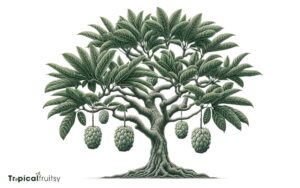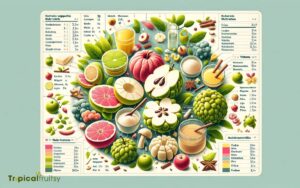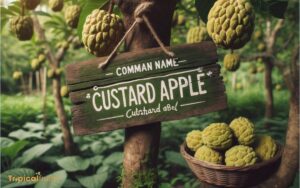How to Take Care of Custard Apple Tree? 7 Easy Steps!
To take care of a custard apple tree, ensure it is planted in well-draining soil with adequate sun exposure. Regular watering, especially during dry spells, is crucial, but avoid waterlogging.
Apply balanced fertilizer during the growing season and prune the tree to maintain its shape and remove dead or diseased branches.
Additionally, protect the tree from pests and diseases by using appropriate organic or chemical treatments as needed.
Custard apple trees (Annona spp.), also known as sugar apple or cherimoya, are tropical fruit trees that require specific conditions to thrive.
Here’s how to care for them in more detail:
Custard apple trees typically fruit within 3 to 4 years if given proper care.
For the custard apple tree to produce its sweet, creamy fruits, attentive care is essential, underlining the importance of balanced cultivation practices.

Key Takeaway
Step 1: Selecting the Perfect Location
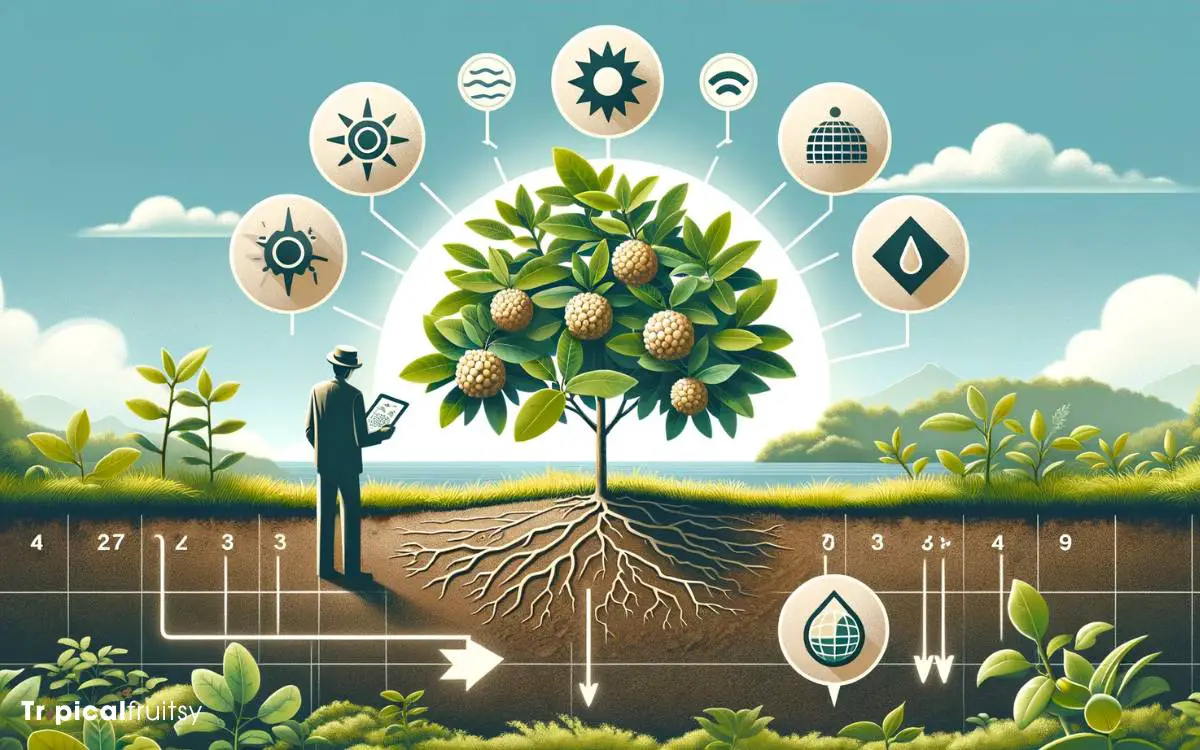
Choosing the right spot for my custard apple tree’s growth is crucial to ensure its health and productivity.
The ideal location must offer full sun exposure, as custard apple trees thrive with ample sunlight, which is vital for fruit development.
I also look for well-draining soil, as waterlogging can be detrimental to the tree’s roots, leading to fungal diseases.
It’s essential to plant the tree in a spot that’s sheltered from strong winds, which can damage branches and flowers, reducing the tree’s yield.
Additionally, I ensure the location has enough space for the tree to expand – custard apple trees can grow quite large.
By meeting these conditions, I’m setting the stage for a healthy tree that’ll provide delicious fruit for years to come.
Step 2: Planting Your Custard Apple
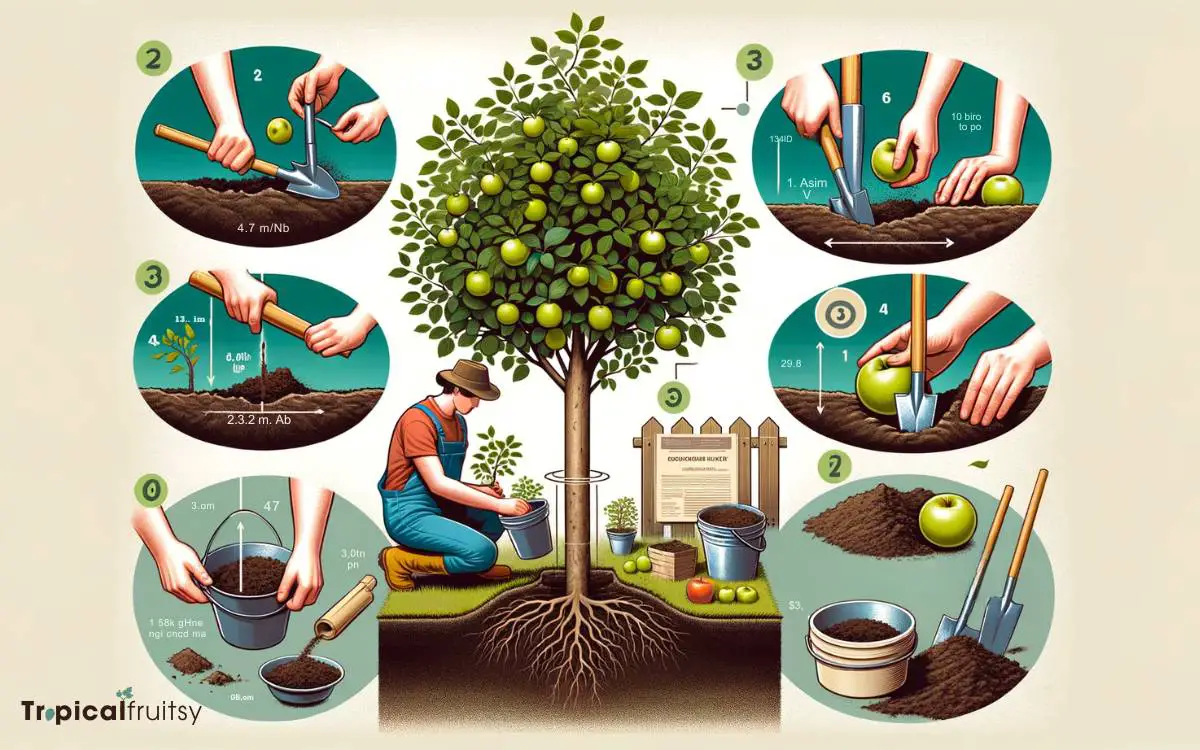
Having selected the perfect spot for your custard apple tree, it’s essential to focus on preparing the soil, which is the foundation of your tree’s health.
We’ll also pinpoint the ideal planting season to ensure your sapling thrives from the start, taking advantage of optimal growth conditions.
Lastly, I’ll explain the importance of proper tree spacing, which is crucial for adequate air circulation and sunlight exposure, leading to a more bountiful harvest.
Soil Preparation
I’ll ensure the soil is well-drained and rich in organic matter before planting my custard apple tree. Proper soil preparation is fundamental for the tree’s growth and fruit production.
Here’s how I’ll go about it:
Test Soil pH and Nutrients
- Custard apples prefer slightly acidic to neutral soil (pH 6.5-7.5)
- I’ll use a soil test kit to determine amendments needed
Improve Soil Structure
- Organic compost or well-rotted manure enhances soil fertility
- I’ll work the organic matter into the soil to a depth of 12-18 inches
Ensure Good Drainage
- Raised beds or mounds can prevent waterlogging
- I’ll plant on a slight slope or modify the landscape to facilitate drainage
These steps will create an ideal environment for my custard apple tree to thrive.
Ideal Planting Season
After ensuring the soil’s fertility, timing becomes critical, as I’ll plant my custard apple tree at the onset of spring to capitalize on the growing season.
This period usually provides ample warmth and mild weather, conditions that foster strong root development and vigorous initial growth.
Planting in spring also offers the advantage of a full growing season before the tree faces the challenges of winter.
I must be mindful, however, of the last expected frost date in my region to avoid potential cold damage to the young sapling.
By waiting until the threat of frost has passed, I give my custard apple the best possible start. It’s about syncing with nature’s rhythms to ensure my tree doesn’t just survive but thrives.
Tree Spacing Requirements
In choosing a spot for my custard apple tree, it’s crucial to account for the space it’ll need to grow—both above and below ground.
The tree requires adequate room to expand its canopy and roots without competing for nutrients and sunlight.
Tree Spacing
- Canopy Growth: Ideally, custard apple trees should be spaced about 15-25 feet apart.
- Root Expansion: This spacing allows roots to spread without overcrowding, which can lead to competition for water and nutrients.
- Air Circulation: Proper spacing ensures good air flow around the tree, reducing the risk of fungal diseases.
Step 3: Watering and Moisture Control
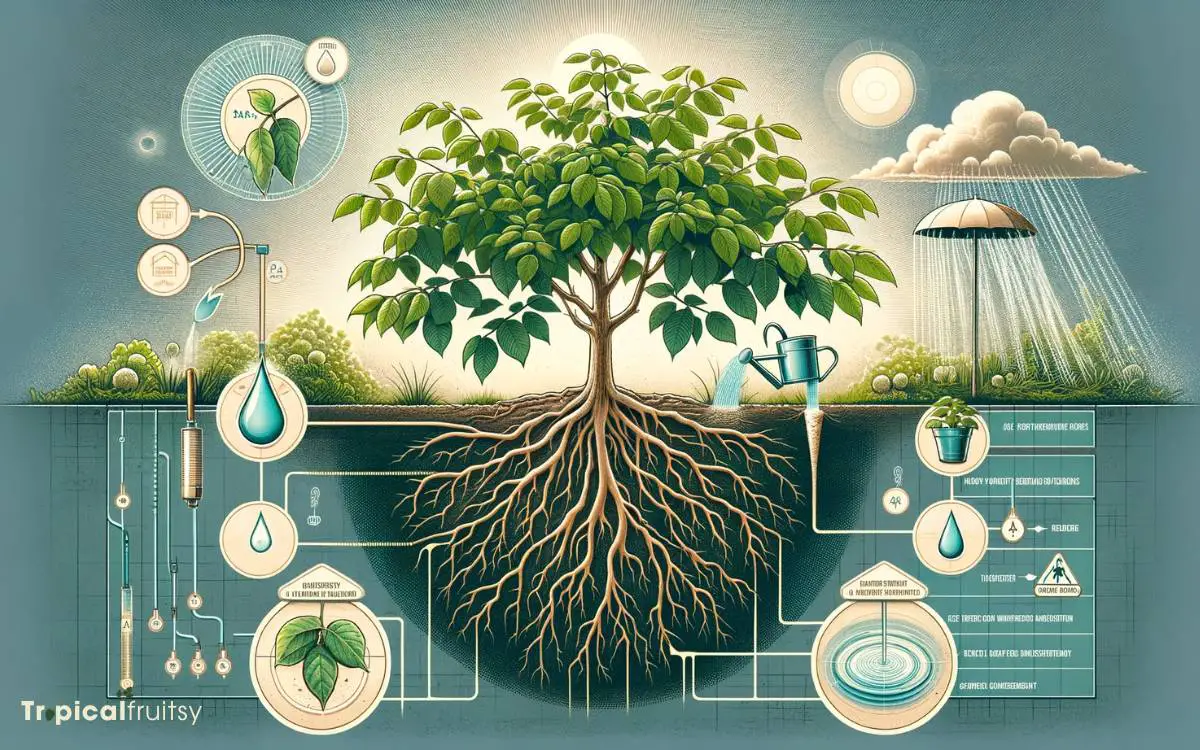
I’ve found that the right watering routine is crucial for the health of a custard apple tree, as it thrives in consistently moist soil. However, it’s important not to over-water, as too much moisture can lead to root rot and other issues.
I recommend checking the soil’s moisture level by sticking a finger about 2 inches deep. If it feels dry at that depth, it’s time to water. During the growing season, this may mean watering once a week, especially in dry conditions.
Ensure the water penetrates deeply to encourage robust root growth but let the soil dry slightly between waterings. Mulching can help retain soil moisture and reduce the frequency of watering.
Step 4: Fertilizing for Optimal Growth
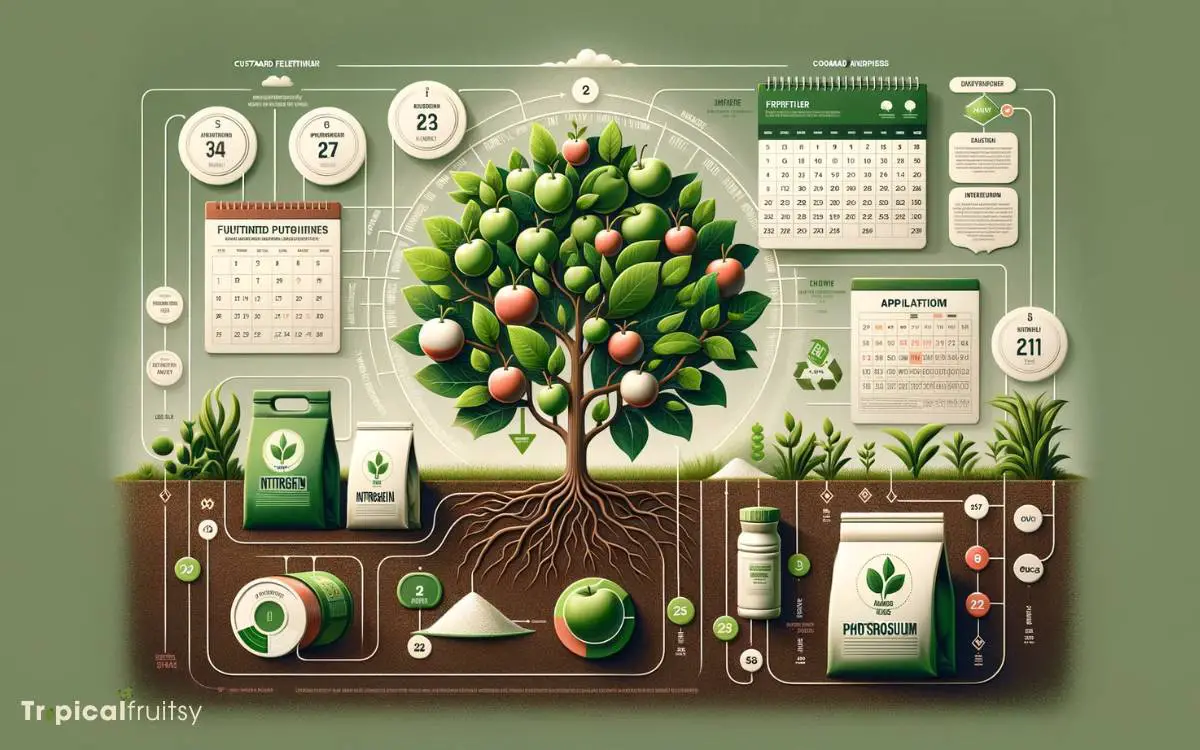
To ensure your custard apple tree receives the necessary nutrients for healthy development, I apply a balanced fertilizer several times during the active growing season.
Here’s how I go about it to maximize the tree’s growth potential:
Balanced Fertilizer Composition
- Nitrogen for foliage growth
- Phosphorus for root development
- Potassium for fruit quality
Timing is also critical. I fertilize:
Fertilizing Schedule
- Early spring to kickstart growth
- Mid-summer to support fruiting
- Late summer to prepare for dormancy
I also take care to:
Application Techniques
- Spread evenly around the drip line
- Avoid contact with the trunk
- Water thoroughly after applying
With the right nutrients in place, the next step in caring for your custard apple tree involves pruning and maintenance techniques.
Step 5: Pruning and Maintenance Techniques
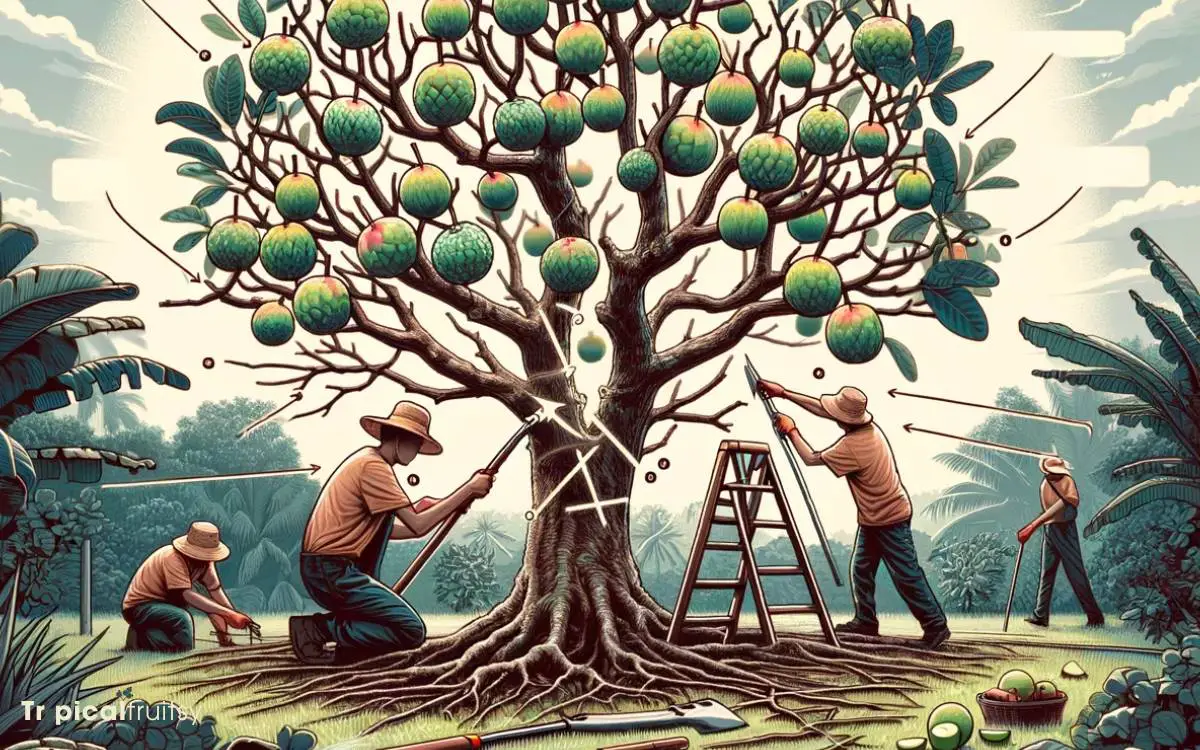
Proper pruning is crucial for the health and productivity of your custard apple tree. There’s an optimal season to do this.
I’ll guide you through effective disease prevention strategies that are essential for maintaining the wellbeing of your tree.
Additionally, I’ll explain how to strike the right balance between fertilization and watering to promote robust growth without compromising the tree’s health.
Optimal Pruning Season
While taking care of a custard apple tree, I find that the best time to prune is during its dormancy period, typically late winter or early spring, before new growth begins.
Pruning in this season helps the tree to direct its energy towards producing robust branches and healthy fruit.
Pruning Techniques
- Thin out crowded branches to improve air circulation
- Remove dead or diseased wood to maintain tree health
- Cut back overgrown limbs to encourage new growth and fruit production
By following these detailed techniques, I ensure that the custard apple tree remains healthy and productive. Proper pruning also sets the stage for the tree to better resist diseases, which is crucial for its long-term care.
Disease Prevention Strategies
After pruning, I implement routine maintenance to prevent diseases that can otherwise compromise my custard apple tree’s health. I start by clearing away pruned debris, which can harbor pests and pathogens.
I also make sure to sterilize my tools before and after each use to prevent the spread of disease. I’m vigilant about monitoring for signs of infection, such as wilted leaves or black spots, which could indicate fungal issues like anthracnose.
If I spot any symptoms, I act swiftly, applying organic fungicides and removing affected areas to stop the spread.
Additionally, I maintain a well-balanced fertilization schedule because a properly nourished tree is more resistant to diseases.
I avoid excessive watering, as standing water can lead to root rot, and ensure good air circulation by spacing trees properly.
Fertilization and Watering Balance
In addition to disease prevention, I’ve learned that maintaining the right balance between fertilization and watering is crucial for the health of my custard apple tree.
To achieve this:
Fertilization
- Organic Compost: I incorporate well-rotted compost into the soil annually, which slowly releases nutrients.
- Balanced Fertilizer: I apply a balanced NPK fertilizer quarterly, ensuring that nitrogen, phosphorus, and potassium are in harmony.
- Micronutrients: I also include micronutrient supplements like zinc and iron to prevent deficiencies.
Watering is just as nuanced. I ensure that the soil is consistently moist but not waterlogged, and during the dry season, I increase watering frequency to counteract the stress on my tree.
Pruning, done after fruiting, removes dead or overcrowded branches, facilitating better air circulation and sunlight penetration, which in turn supports healthier growth.
Will Pruning a Custard Apple Tree Help with Overall Care and Maintenance?
Pruning custard apple tree steps are essential for overall care and maintenance. Regular pruning helps to shape the tree, remove dead or diseased branches, improve air circulation, and promote new growth. It also ensures better fruit production and quality. Proper pruning techniques are crucial for maintaining a healthy and productive custard apple tree.
Step 6: Protecting From Pests and Diseases
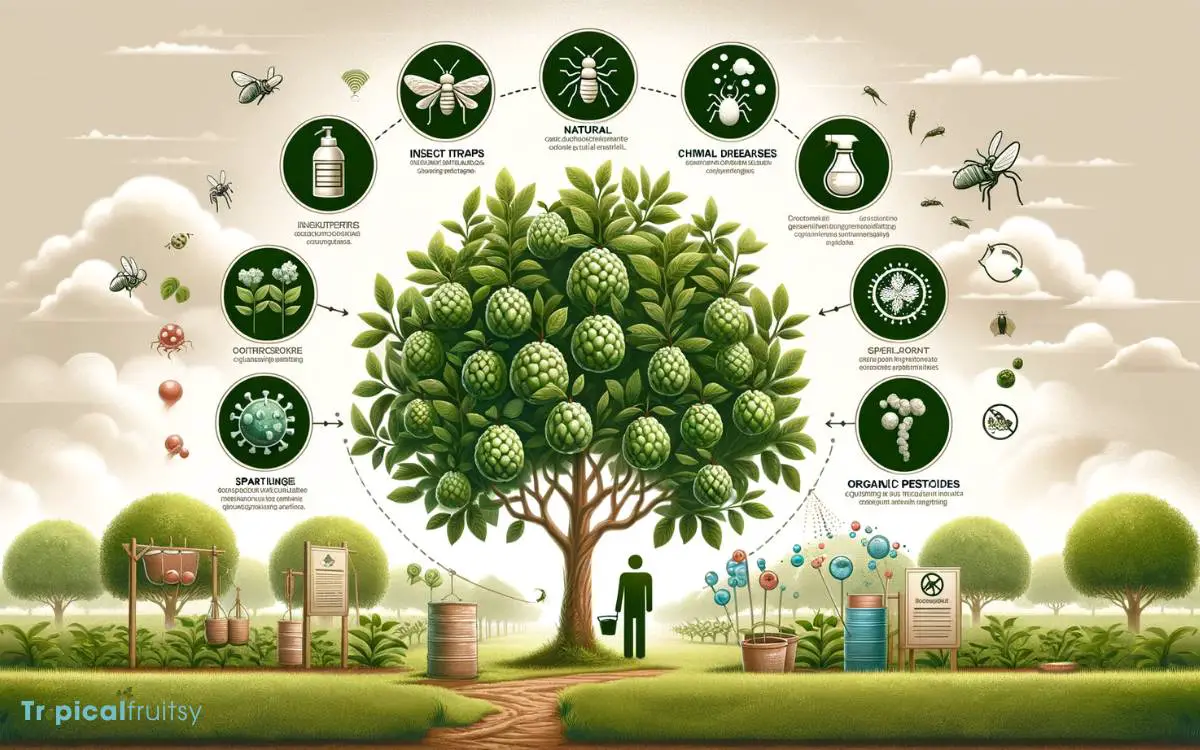
I’ve identified several common pests and diseases that can threaten a custard apple tree, and I’ll show you how to protect your tree from these potential problems.
Aphids, mealybugs, and scale insects are notorious for attacking custard apple trees. To manage these pests, I recommend using neem oil or insecticidal soap, which are both organic and effective.
For fungal diseases like anthracnose, which causes fruit rot and leaf fall, ensure proper air circulation by pruning and apply copper-based fungicides at the first sign of infection.
Another common issue is the fruit borer, which can devastate your harvest. To combat this, I use pheromone traps to monitor and reduce their population.
Regularly inspecting your tree for any signs of distress and taking immediate action is crucial for keeping pests and diseases at bay.
Step 7: Harvesting and Storing Fruit
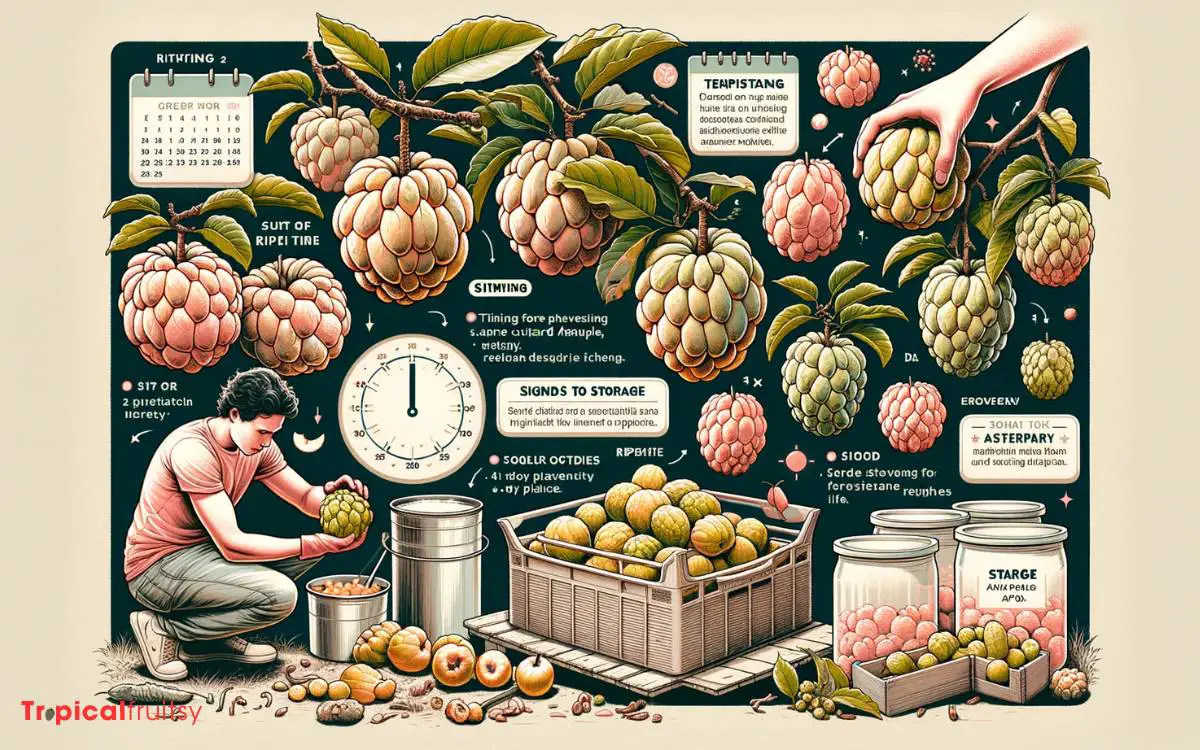
My custard apple tree’s bounty is ready for harvest when the fruits’ skin turns from green to a pale yellow or brownish color, indicating peak ripeness for storage.
Here’s how I ensure the best quality of the harvested fruit:
Inspecting the Fruit
- Gently squeeze for slight give
- Look for a full, rounded shape
- Check for a sweet, fragrant aroma
Harvesting
- Use pruning shears for a clean cut
- Leave a short stem to prevent bruising
- Harvest in the morning for optimal freshness
Storing
- Place in a cool, dry area
- Avoid stacking to minimize pressure damage
- Monitor regularly for signs of over-ripeness or spoilage
Conclusion
After months of nurturing my custard apple tree, it’s a joy to see it burst into a bouquet of bountiful fruit.
Like a proud parent watching a child flourish, I’ve seen firsthand how the right mix of sun, water, and care can yield a cornucopia of sweet rewards.
With pests kept at bay and the branches pruned just so, my tree stands as a testament to the fruitful results of patience and dedication.
Now, it’s time to savor the fruits of my labor.

